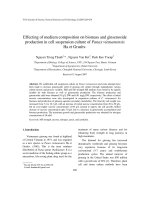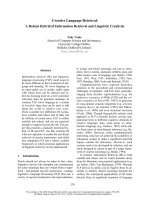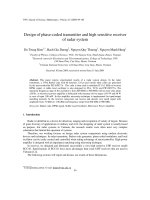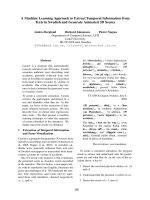Báo cáo " Imperialism of communicative language teaching and possible resistance against it from teachers in Vietnam as an English foreign languages context " doc
Bạn đang xem bản rút gọn của tài liệu. Xem và tải ngay bản đầy đủ của tài liệu tại đây (163.08 KB, 8 trang )
VNU Journal of Science, Foreign Languages 24 (2008) 167-174
167
Imperialism of communicative language teaching and
possible resistance against it from teachers in Vietnam as an
English foreign languages context
Khoa Anh Viet
*
Department of English - American Language and Culture, College of Foreign Languages,
Vietnam National University, Hanoi, Pham Van Dong Street, Cau Giay, Hanoi, Vietnam
Received 08 May 2008
Abstract. This paper deals with the domination of communicative language teaching (CLT) which
has become popular in teaching foreign languages. However, the application of CLT has caused
difficulties for students, teachers and administrators. Within the scope of this paper, only teachers
are mentioned so that we can see a part of teaching issues when CLT is introduced. The paper also
suggests more research should be conducted based upon the factors of students and administrators
in order that we can take proper steps in language training in the country.
1. Introduction
*
English, undeniably, has become a
phenomenon in the world and it is irresistible
language. It spreads the five continents like a
magic power. According to Crystal (as cited
in McKay [1]), several major factors which
ignite the spread of English are colonialism,
speaker migration, and new technology
created in English-speaking countries. He
claims that other intellectual, economic, and
cultural factors also play some roles in this
flow of English influence on other countries
across the globe. There are approximately 70
countries which consider English an official
language. The total estimated number of
English speakers reaches 580,000,000, not to
mention other countries which choose
English their foreign language with an
estimated 750,000,000 speakers.
______
* Tel.: 84-4-8337525
E-mail:
In order to maintain its strong spread, a
certain system involving methodology and
teaching staff will have to take the
responsibility. Looking back the history of
language teaching, we have experienced
different approaches, namely the Grammar
Translation Approach, the Direct Method, the
Audiolingualism, and most recently
Communicative Language Teaching (CLT).
CLT owes its popularity to the spread of
English and it is supported to be a dominant
approach in English Language Teaching
(ELT). This issue will be further dealt with in
the section of imperialism of CLT.
2. Body
2.1. What is linguistic imperialism?
The powerful spread of English reminds
us of a linguistic imperialism. Phillipson (as
cited in Pennycook (2001) [2], defines English
Khoa Anh Viet / VNU Journal of Science, Foreign Languages 24 (2008) 167-174
168
linguistic imperialism in the way that “[t]he
dominance of English is asserted and
maintained by the establishment and
continuous reconstitution of structural and
cultural inequalities between English and
other languages”. To illustrate this view,
Crystal (as cited in McKay, 2002) states that
there are 12,500 international organizations,
85 % of which consider English an official
use. Approximately 85 % of the world film
markets are controlled by the United States of
America. 99% of the pop groups in English
are listed in the encyclopedia of music. The
world’s electronic information in English
accounts for about 80%. English is used in
schools in many countries. To sum up,
English penetrates into different areas of
politics, economics, culture, and society.
2.2. The imperialism of communicative language
teaching
To begin with, I would like to focus on
the development of CLT. Communicative
language teaching can be regarded as a
phenomenon and a great achievement in the
search for better approaches. Savignon (1991)
[3] attributes the increasing number of
immigrants and workers in Europe, the neo-
Firthian system, writings of Jurgen Habermas
(1970, 1971), Hymes (1971), Candlin,
Edelhoff, and Piepho (1978), Halliday (1978),
to the birth of CLT. CLT is also based on the
Monitor Model, an “influential model of
learning in the second language literature”
by Krashen (S.M. Gass and L. Selinker (2001)
[4]). McKay (2002) states that CLT gains its
popularity as a contrast to audiolingualism
totally basing on behaviorist view of language
learning and focusing on form of language
rather than its meaning. CLT is a
communicative approach and its ultimate goal
is to develop to communicative competence.
Communicative competence includes
grammatical competence, discourse
competence, sociolinguistic competence, and
discourse competence (Hymes as cited in
Savignon, 1997 [5]).
According to Tollefson (1991) [6], the
spread of English is related to ‘modernization
theory’ which claims that “Western societies
provide the most effective model for
‘underdeveloped’ societies attempting to
reproduce the achievements of
‘industrialization’ ”. Holliday (as cited in
McKay, 2002) argues that the spread of CLT
is a vivid proof of modernization theory.
McKay (2002, p. 109) states, “… English has
spread because of the tremendous interest in
learning the language, so too in many cases
CLT has spread not only because of the
promotion of the approach by western
specialists but also because educators in these
countries have advocated its adoption.” He
also adds that CLT promotion has been
strengthened by “the tendency to extend the
assumptions of Inner Circle [countries where
English is a dominant language] about
English to other countries” (p. 118) and by a
large industry of textbook that is in favour of
communicative approaches. Savignon (2003)
[7] holds that CLT is being applied and
applauded by a number of countries, namely
Japan, Hong Kong, Costa Rica, Taiwan, the
European Union, not to mention countries
where English is regarded as the first
language and second language. Some
researchers even view CLT as an event of
“pedagogical imperialism”.
2.3. Possible resistance from teachers against CLT
in Vietnam as an EFL context
Vietnam is not an exception from the
spread of English and CLT. Since the
introduction of doi moi (renovation)
Khoa Anh Viet / VNU Journal of Science, Foreign Languages 24 (2008) 167-174
169
implemented through the open-door policy,
English has gained its priority over other
foreign languages, namely Russian, French,
and Chinese, because the Vietnamese Party
and State realise its significant role in
modernisation and industrialisation. At the
Central Party Committee on education in
December 1996, English was officially
regarded as the first foreign language to be
taught in schools. In addition, more people
both young and old learn English for several
reasons, namely job-seeking, travelling, and
further education. In brief, English can bring
them a better life and bright future.
In the field of English teaching, Vietnam
has experienced a gradual shift from the old
tradition way of teaching to more up-to-date
ones. Communicative Language Teaching is
in the list of new ways of teaching. Many
schools and universities are attempting to
employ CLT into syllabus design,
examinations, and teaching. However, these
attempts face resistance from language
policy-makers, researchers, teachers and
learners. Within the scope of the paper, I
would like to focus on the possible resistance
against CLT from teachers in Vietnamese as
an EFL context. I will deal with the teachers’
misconception of CLT, their methodology,
the relationship among them, the relationship
between teachers and learners, teachers’
training program, and their salary.
- Teachers’ misconception of CLT
Since the birth of CLT, communicative
competence has been further discussed by
Savignon, Celce-Murcia et al (inspired from
Canale and Swain), Bachman, and Brown. It
is interpreted in different perspectives. Sato
& Kleinsasser (1999) [8] state that different
interpretations of CLT are originated from
these different perspectives. Therefore,
misconception of CLT is inevitable.
According to Thompson (1996) [9], the
misconception is that CLT means not
teaching grammar, teaching only speaking,
completing pairwork, and expecting too
much from teachers. To some extent, it is also
the case with several teachers in the English
Department of VNU - CFL (Vietnam National
University, Hanoi - College of Foreign
Languages). Before CLT was introduced,
grammar had been the main discussion in the
classroom. Teachers taught grammar and
learners learned English through grammar.
However, when the Department changed its
policy of language teaching, CLT was given
top priority. All the teachers in the
Department had to and still have to adjust
themselves to the new tendency. Grammar is
no more treated as an important part in the
classroom. What the teachers are trying to do
is increase the students’ talking time. Among
new and old-fashioned teachers, there is a big
challenge because they actually do not know
what exactly CLT means or they only have
some general idea about CLT. One of my
colleagues says it is believed that “the main
function of language is to communicate and
the main purpose of language teaching is to
help students communicate in English” and
in practice it focuses on “language skills
rather than on language knowledge,
communication tasks.” Another one says
CLT means:
Teaching language using the approaches so
that students will be able to use the language in
the real communicative situations, meaning
teaching with focus on language functions rather
than the grammar, using more simulations, role
plays, and games.
Another opinion is that
I understand CLT as the language teaching
method which sees the aim of language teaching
Khoa Anh Viet / VNU Journal of Science, Foreign Languages 24 (2008) 167-174
170
as for the purpose of meaningful communication,
and language as the means for that purpose. The
focus of language teaching, therefore, is on the
language in use with all the 'stuff' that go with it
like linguistic & sociolinguistic knowledge,
communication strategies, etc. rather than on the
language by itself.
- Teachers’ methodology
Traditionally, teachers are considered to
be the most powerful person and the centre
in the classroom. This viewpoint is
influenced by Confucian ideology. Le (1999)
[10] states the environment of English
learning in Vietnam can be compared to “a
cultural island where the teacher is expected
to be the sole provider of experience in the
target language”. Hall (1998) [11] states:
“Teachers who view themselves as
leaders of communities of inquiry, who view
students as active agents in the learning
process and thus take their involvement
seriously, are more likely to engage their
students in intellectually challenging
interactions. Teachers who perceive
themselves as authorities of knowledge and
students as passive recipients of their
knowledge are more likely to use the
standard I-R-E. [I: Teacher initiates; R:
Students response; E: Teacher evaluates]”.
Undeniably, the model of I-R-E is still so
popular in the majority of Vietnamese
teachers. In other words, the teacher-centered
approach still plays a key role in language
teaching. Meanwhile, CLT (Savignon, 2003)
by definition regards learners as the center in
the classroom. Therefore, there exists a
potential conflict between I-R-E and CLT.
- Among teachers
Hargreaves (1992) [12] claims, “teachers
do not develop their strategies and styles of
teaching entirely alone… Over the years
these colleagues develop ways of doing
things, along with whole network of
associated educational beliefs and values in
response to the characteristic and recurrent
problems and circumstances they face in
their work”.
The cultures of teaching which Hargreaves
(1992, p. 217) defines as “beliefs, values,
habits and assumed ways of doing things
among the communities of teachers” has a
powerful effect on teachers. CLT is not really
a popular thing for old teachers who have
still applied the Grammar Translation
method and those who begins teaching and
are eager to apply new things into their
teaching may face resistance. In other words,
there is clearly a pedagogical conflict
between teachers using traditional methods
and those applying new methods.
Paradoxically, the old experienced teachers
have a very powerful influence on the new
inexperienced ones.
From my observation, the idea of sharing
teaching materials and experience among
teachers is still not taken into serious
consideration. Several explanations can be
made. Possibly, Vietnamese teachers are
living in the world of competition. They want
to be the best teachers and regard what they
know about language and teaching as a
secret. Or no precedent of sharing among
teachers has been created. It is also likely that
sharing is not really important in the
teachers’ mind.
Worse still, teachers feel uncomfortable or
reluctant when their colleagues attend their
class. Teachers only let others to attend their
lessons when they are close friends or when
they have to sit for examinations or when
they are inspected by educational officials.
CLT (Savignon, 1997) requires teachers and
students to build a community of learning
and teaching where there is no fear of failure
and where sharing is for common interests.
- Teachers and students
Khoa Anh Viet / VNU Journal of Science, Foreign Languages 24 (2008) 167-174
171
In the classroom, teachers and students
interact so that teaching and learning can
take place. Teachers have to deal with
different types of students. The main duty of
teachers is to design activities to cater their
students’ different levels of proficiency,
needs, and interests. Since CLT was
introduced, the teacher’s roles have been taken
into consideration. Breen and Candlin (cited in
Richards and Rodgers (1986) [13]) claim:
“The teacher has two main roles: the first
role is to facilitate the communication process
between all participants in the classroom,
and between these participants and the
various activities and texts. The second role is
to act as an independent participant within
the learning-teaching group… A third role
for the teacher is that of researcher and
learner, with much to contribute in terms of
appropriate knowledge and abilities, actual
and observed experience of the nature of
learning and organizational capacities.”
Le (1999) states:
“In general, students of English in
Vietnam fall into three major categories in
terms of needs. Some view English as a tool
for more attractive and lucrative employment
opportunities; others need a good knowledge
of English to study further at universities or
colleges. The majority of students, however,
learn English just to pass the national
examinations. These students do not have an
obvious communicative need. All they need
is a sufficiently good knowledge of grammar
and vocabulary of the target language to pass
the national grammar-based and norm-
referenced examinations.”
The problem that CLT teachers often face
is when their learners have no
communicative needs. CLT (Savignon, 1997)
is a communicative approach which aims at
developing communicative competence
(including grammatical competence,
sociocultural competence, discourse
competence, and strategic competence). My
colleagues who are so in favour of CLT often
complain that their students tend to treat
communicative activities as games and from
this point of view they do not seem to learn
anything in order to pass the examinations.
Under this pressure, many teachers resort to
traditional methodology. They provide
students with knowledge of grammar and
grammar exercises dominate the classroom
environment.
CLT can also be described as a learner-
centered approach and Weimer (2002) [14]
argued that when applying this approach,
teachers may face resistance from students.
Take my case as an example. I have been
teaching English at the College of Foreign
Languages – Vietnam National University,
Hanoi for nearly 6 years. The college’s main
function is training teachers and interpreters.
Once, I applied the technique “Let your
students teach their class” proposed by Ogawa
and Wilkinson (1997) [15] in the class of 24
first-year students to renew teaching and
learning environment. Later on, I had both
positive and negative feedback. Better
students said they loved the activity because
it gave them a chance to prove themselves.
Others complained that they had more work
and difficulties in carrying out the activity and
they were even frightened of it.
- Teachers’ language training program
Usually, teachers’ training programs are
held at different levels of educational
institutions, namely schools, universities,
municipal/provincial Department of
Education and Training, and Ministry of
Education and Training. Besides, there are
several foreign-funded educational
organizations such as UNESCO, British
Khoa Anh Viet / VNU Journal of Science, Foreign Languages 24 (2008) 167-174
172
Council, IDP, which also offer seminars,
workshops, conferences, and teaching
materials. In general, when they take part in
these programs, CLT is not only the issue
that is discussed. Rather, a structural
curriculum still holds its irreplaceable role.
Even when CLT receives attention, it is not
clearly expressed. It can be said that there
have been no large-scale discussions on CLT.
This situation is just the same as that of
Australia where Sato and Kleinsasser (1999)
conducted their survey into the practical
understanding of CLT. They claim, “Teachers
who attended a teacher development course
gained some ideas about CLT but did not
seem to have very thorough explanations of
what CLT meant” (p. 511).
- Teachers’ salary
Salary for teachers is a big issue in
Vietnam. Even though their salary ranks the
second in the list after military officers.
However, the salary is not enough for their
living, let alone their teaching career.
Teachers’ salary varies from the elementary
level to tertiary level. On average each
teacher receives a salary from VND 1,000,000
to VND 4,000,000. Because they have to work
extra time or extra job to earn more money,
they do not spend sufficient time on their
lesson plan, scientific research, and other
training programs. This problem is shared by
Pham (2006) [16] who claims that he has to
earn extra money as a freelance translator
because of the modest salary as full-time
lecturer at the university, which leaves him
little time to carry out research. CLT requires
teachers to be engaged seriously in teaching a
language. Teachers not only prepare lessons
before the classroom, teach during the lesson,
but also get contact with learners outside the
classroom. To make the matter worse, CLT
teachers have to reproduce the activities
which do not carry any communicative
purposes in the book. Glisan & Drescher (as
cited in Kleinsasser (1996) [17] claims:
“… despite today’s widespread
acceptance of teaching language for oral
communication, current textbook grammar is
still a reflection of classical grammatical rules
based on formal, written language”.
In brief, within their inadequate salary
teachers will find it a big challenge to apply
CLT.
3. Conclusion
So far I have argued that CLT is an event
of pedagogical imperialism. However, it
faces resistance from teachers in Vietnam as
an EFL context because of their
misconceptions of CLT, their methodology,
the relationship among teachers and between
teachers and students, their training program
and salary.
This paper hopefully gives language
policy-makers food for thought in Vietnam
before they introduce the communicative
curriculum into language classroom. They
should pay due attention to the present
situation of teachers. The unanswered question
is what should be done to increase the quality
of teachers’ profession and their life. The paper
also helps raise teachers’ awareness of applying
CLT. There are still risks they have to face
inside and outside the classroom.
The paper also suggests that future
researches should be conducted into the
possible resistance against CLT from
language policy-makers, researchers, and
learners so that a comprehensive view of CLT
will be formed. The future of language
teaching in Vietnam will experience
tremendous changes in the flow of
methodology. CLT globally can be
considered a fashion. However, when it is
Khoa Anh Viet / VNU Journal of Science, Foreign Languages 24 (2008) 167-174
173
placed into a local context of a specific
country, much still needs to be done.
Undeniably, whether or not any approach
proves effective depends so much on a
harmonious combination of policy-makers,
researchers, teachers and learners in a
specific context.
References
[1] S. L. McKay, Teaching English as an international
language, Oxford: Oxford University Press, 2002.
[2] A. Pennycook, Critical applied linguistic: A
critical introduction, USA: Lawrence Erlbaum
Associates, Inc., Publishers, 2001.
[3] S. J. Savignon, Communicative language
teaching: State of the art, TESOL Quarterly 25
(1991) 261.
[4] S. M. Gass, L. Selinker, Second language
acquisition - An introductory course, London:
Lawrence Erlbaum Associate, 2001.
[5] S. J. Savignon, Communicative competence: Theory
and classroom practice, Second edition, New York:
MacGraw-Hill Companies, Inc., 1997.
[6] J. W. Tollefson, Planning language, planning
inequality, London: Longman, 1991.
[7] S. J. Savignon, Teaching English as
communication: A global perspective, World
Englishes 22 (2003) 55.
[8] K. Sato, R. C. Kleinsasser, Communicative
Language Teaching (CLT): Practical
Understandings, The Modern Language Journal
83 (1999) 494.
[9] G. Thompson, Some misconceptions about
communicative language teaching, ELT Journal
50 (1996) 9.
[10] Le Van Canh, Language and Vietnamese
pedagogical contexts, Retrieved 20 December,
2007, from
/>gs/canh.htm, 1999. A. S. Canagarajah, Resisting
Linguistic Imperialism in English Teaching, Oxford:
Oxford University Press, 1999.
[11] J. K. Hall, The Communication Standards, In J. K.
Philips (Ed.), Foreign language standards: Linking
research, theory, and practice, Lincolnwood, IL:
National Textbook Company, 1998.
[12] A. Hargreaves, M. G. Fullan, Understanding
teacher development, New York: Teachers
College Press, 1992.
[13] J. C. Richards, T. S. Rodgers, Approaches and
methods in language teaching: A description and
analysis, Cambridge: Cambridge University
Press, 1986.
[14] M. Weimer, Learner-Centered Teaching, San
Francisco: Jossey-Bass, 2002.
[15] N. Ogawa, E.D. Wilkinson, Let Your Students
Teach Their Clas, Retrieved March 29, 2004,
from />StudentsTeach.html, 1997.
[16] Pham Hoa Hiep, Researching the research
culture in English Language Education in
Vietnam, Retrieved 20 December, 2007, from
/>EJ/ej38/a10.html, 2006.
[17] R. C. Kleinsasser, Communicative grammar
instruction: Why elementary language textbooks fail
us, In C. A. Sola, J. R. Ianziti, R. Sussex (Eds.),
Who's afraid of teaching grammar?, Brisbane,
Qld: CLTR, 1996.
Khoa Anh Viet / VNU Journal of Science, Foreign Languages 24 (2008) 167-174
174
Sự bành trướng của phương pháp dạy học theo đường
hướng giao tiếp và những khả năng chống lại từ phía giáo
viên Việt Nam trong bối cảnh tiếng Anh là một ngoại ngữ
Khoa Anh Việt
Khoa Ngôn ngữ và Văn hoá Anh - Mỹ, Trường Đại học Ngoại ngữ,
Đại học Quốc gia Hà Nội, Đường Phạm Văn Đồng, Cầu Giấy, Hà Nội, Việt Nam
Bài viết này đề cập tới sự thống trị của việc giảng dạy ngoại ngữ theo đường hướng giao tiếp
(CLT). Đây là một trong những xu thế phổ biến trong việc dạy ngoại ngữ hiện nay. Tuy nhiên
việc áp dụng đường hướng này gặp phải những khó khăn xuất phát từ phía giáo viên, sinh viên,
và người quản lí. Trong khuôn khổ bài viết này, yếu tố giáo viên sẽ được bàn đến để chúng ta
thấy một phần của bức tranh giảng dạy khi áp dụng đường hướng này. Bài viết cũng gợi ý
những nghiên cứu tiếp theo liên quan đến sinh viên và người quản lý để chúng ta sẽ có những
bước đi đúng đắn trong việc đào tạo ngoại ngữ trong nước.








